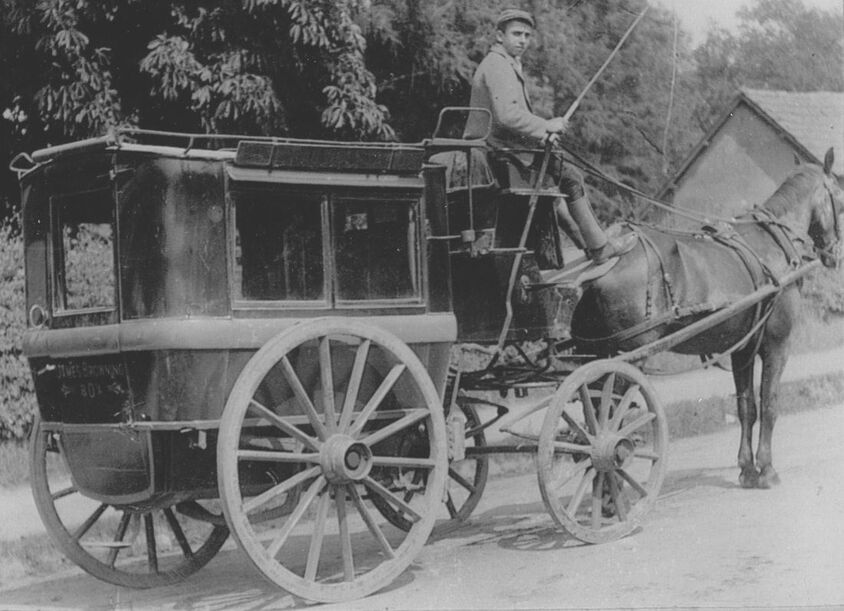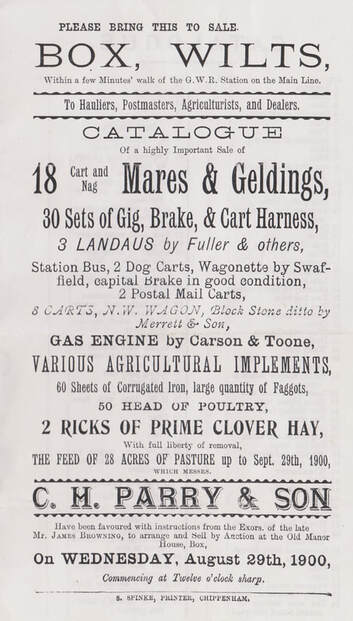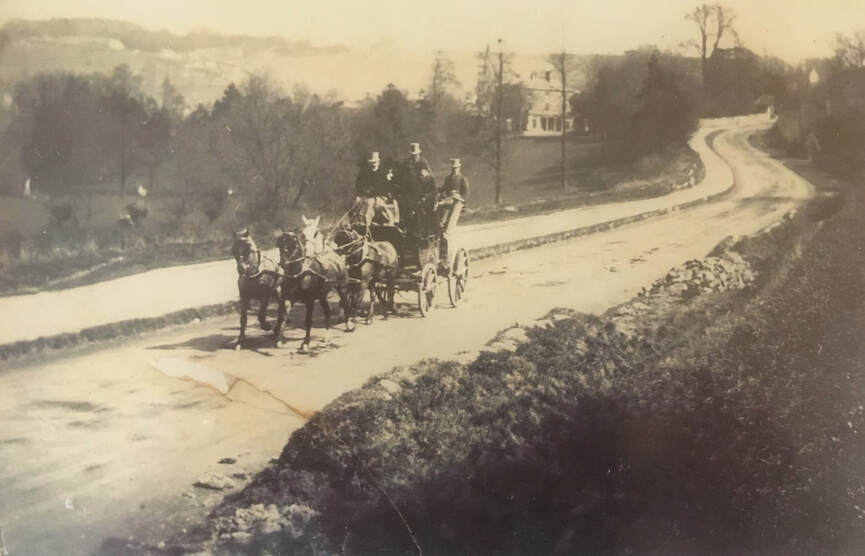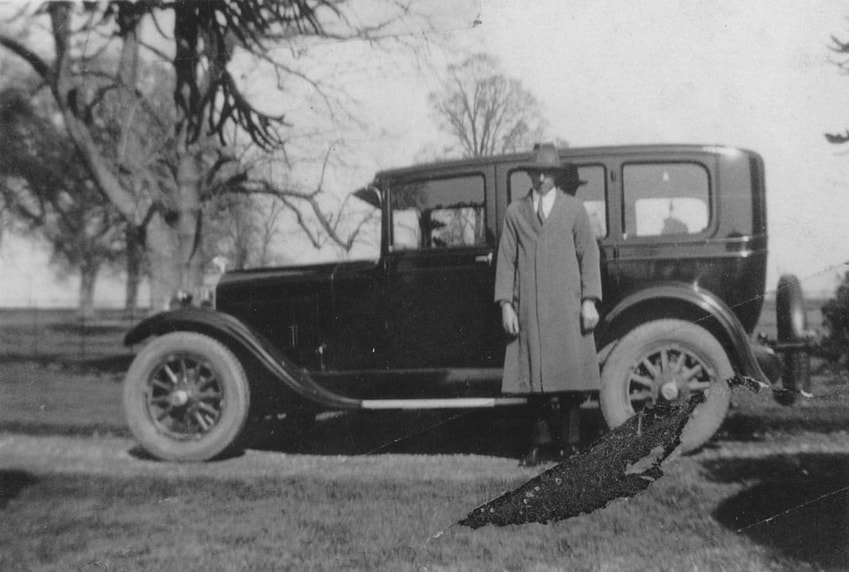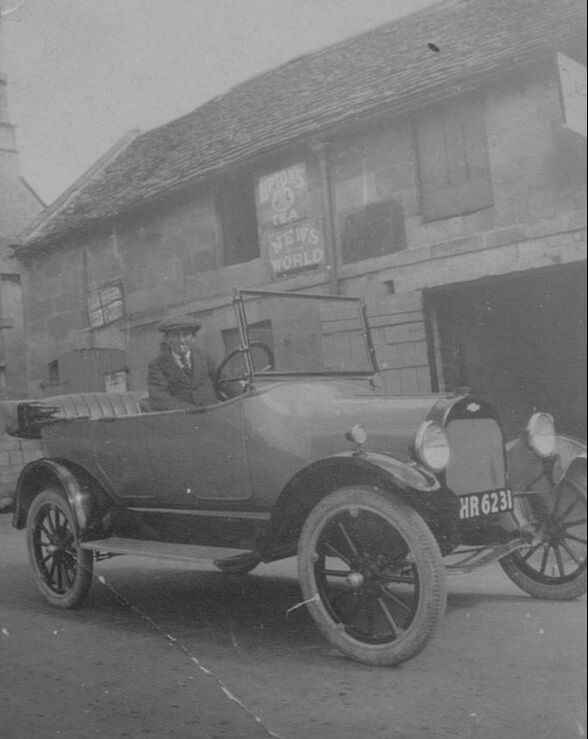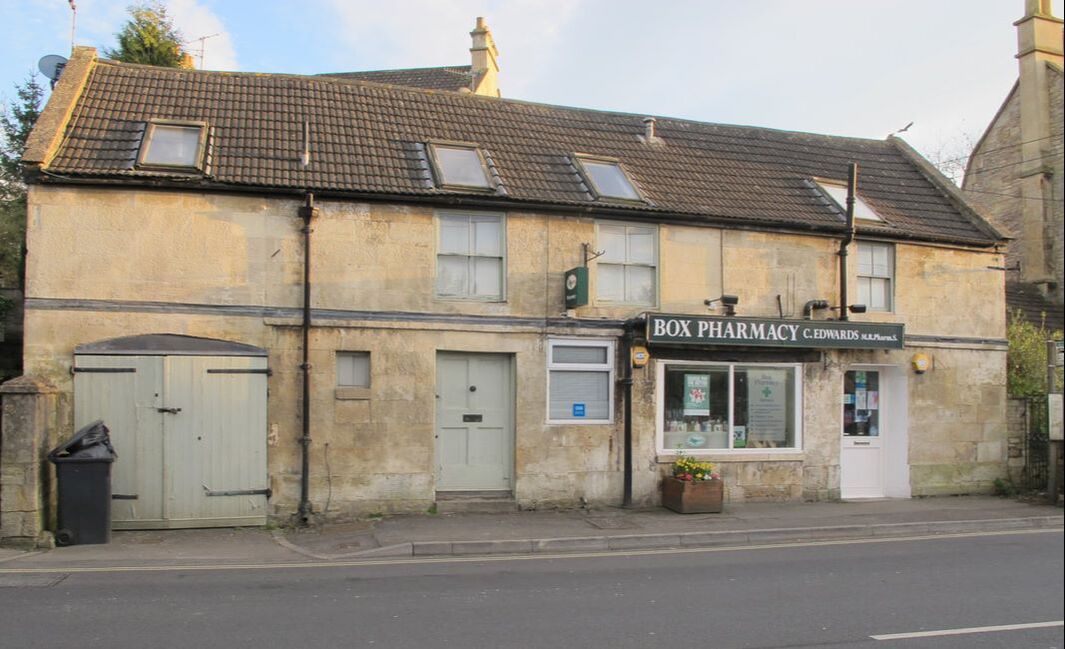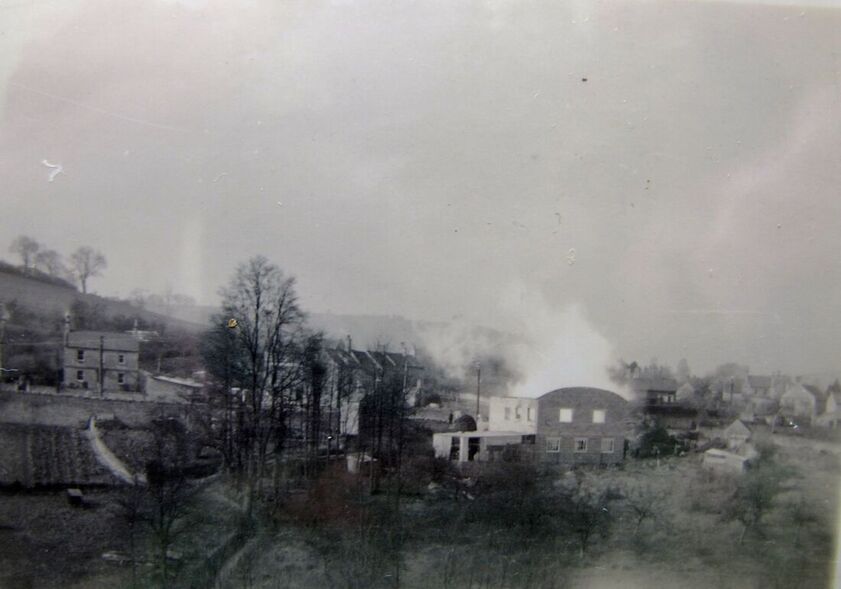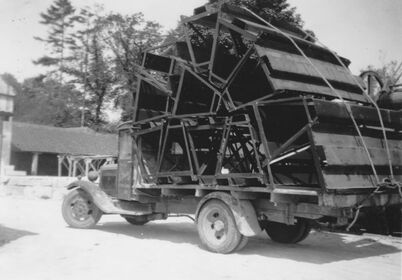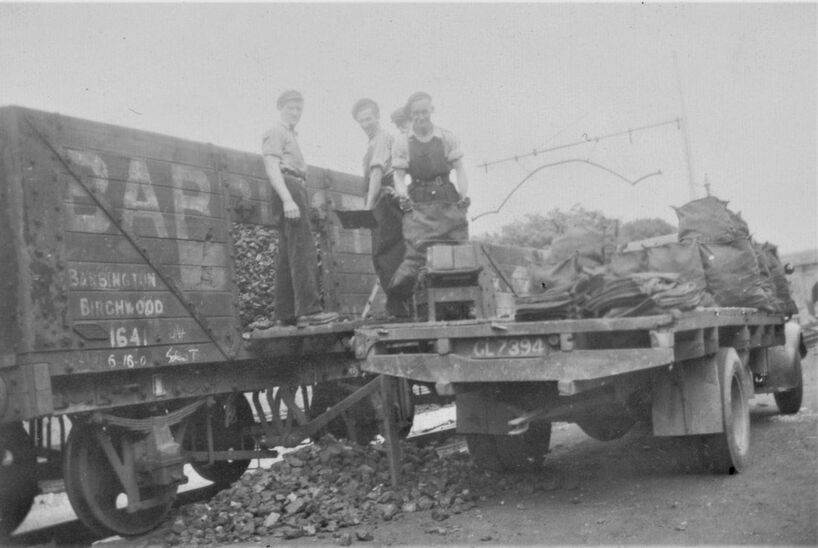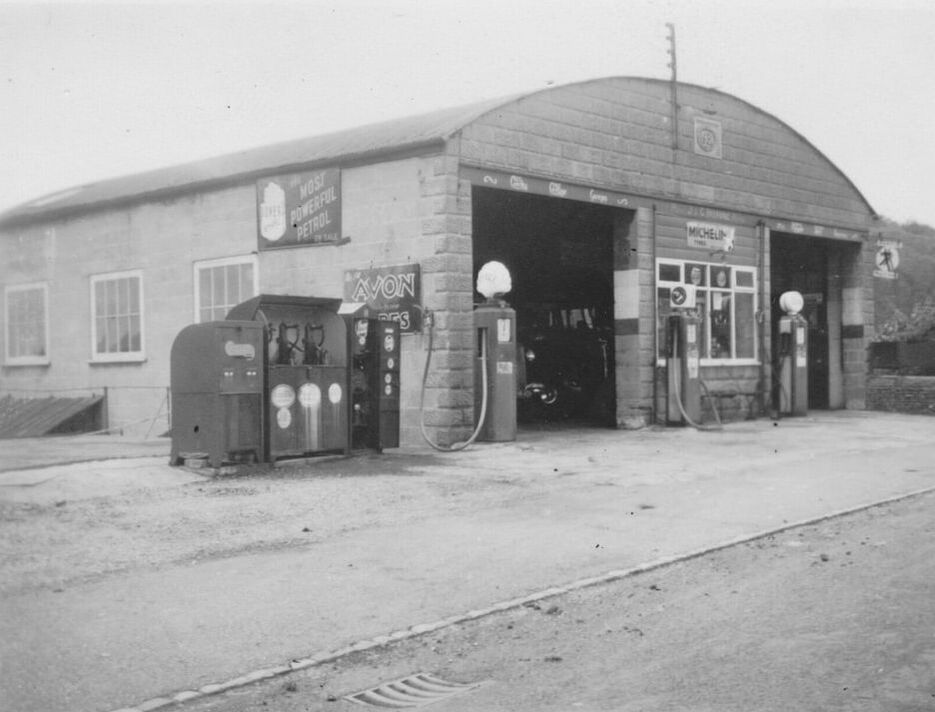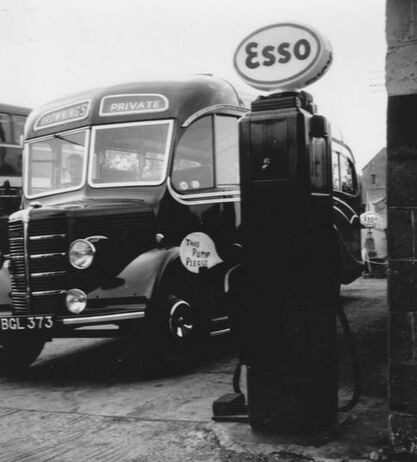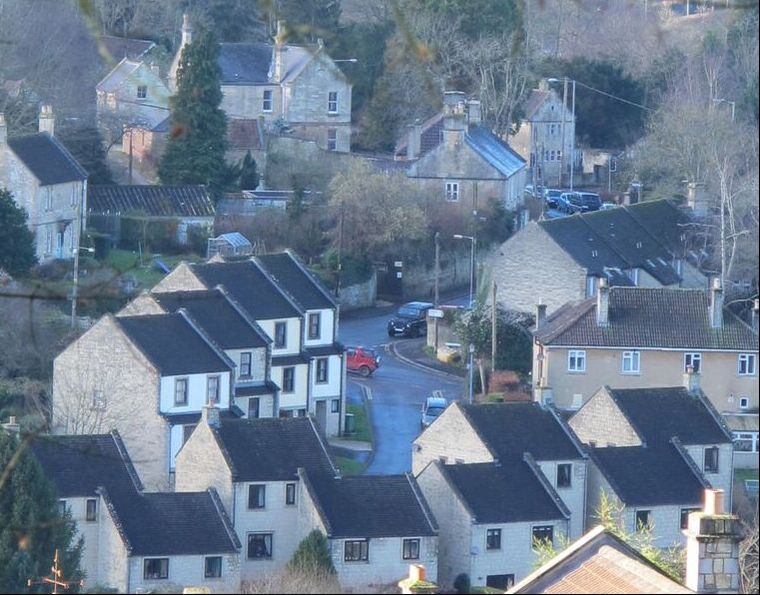Browning's Coaches: Motor Hauliers in Box
Text Alan Payne June 2020
Research and Photos Jim Browning, Anne Pothecary (nee Browning) and Richard Browning
Text Alan Payne June 2020
Research and Photos Jim Browning, Anne Pothecary (nee Browning) and Richard Browning
Browning is one of those local names known to most Box residents. One branch of the family were millers at Drewetts Mill, another branch started a haulage and motor repair trade in the centre of Box and the name is now commemorated in the area called “Brownings” at the top of Chapel Lane, where they had their garage premises.
Carriages to Coaches
The family came to Box from Colerne when Thomas and Charlotte Browning took over Drewetts Mill. They had two sons, John and George, who were trained as millers but it was John alone who took over the miller's business on his father’s death in 1867.
George (1827-1901) tried to start an alternative business, the Steam Mill in the Market Place which failed by 1871 and he became a baker and corn factor, ending at Springfield Villa as Assistant Overseer of the poor of Box.[1] It was George’s son, James (1863-1900), who started a haulage trade when still in his twenties. In 1887 James married Emma Jane Carter (b 1859) of Monkton Kirby, Warwickshire, who had moved down to Clutton, Somerset. They lived at Burton House, Box High Street, in 1891 where James called himself a fly-proprietor.
The family came to Box from Colerne when Thomas and Charlotte Browning took over Drewetts Mill. They had two sons, John and George, who were trained as millers but it was John alone who took over the miller's business on his father’s death in 1867.
George (1827-1901) tried to start an alternative business, the Steam Mill in the Market Place which failed by 1871 and he became a baker and corn factor, ending at Springfield Villa as Assistant Overseer of the poor of Box.[1] It was George’s son, James (1863-1900), who started a haulage trade when still in his twenties. In 1887 James married Emma Jane Carter (b 1859) of Monkton Kirby, Warwickshire, who had moved down to Clutton, Somerset. They lived at Burton House, Box High Street, in 1891 where James called himself a fly-proprietor.
|
Sale of Carriage Business, 1900
James ran a livery (horse) trade and dealt in horse-drawn vehicles at Manor Farm, Box until his death in August 1900. The yard at Manor Farm had been used for farm maintenance and had a wonderful presence on Box High Street. He also traded as a cab proprietor and coal merchant. The trade was mostly haulage, collecting parcels and goods from Box Railway Station and taking them to local destinations. The collection and delivery of coal was one of the main elements. The stock sold by the executors was advertised to Hauliers, Postmasters, Agriculturalists and Dealers. It was mainly a horse-drawn trade with horses and agricultural equipment: 18 Cart and Nag Mares & Geldings, 3 Landaus, 2 Dog Carts, Wagonette, Various Agricultural Equipment, 50 Head of Poultry and 2 Ricks of Prime Clover Hay. There were also specific horse-drawn carriages including Station Bus (possibly meaning a railway parcels carriage) and 2 Postal Mail Carts. James and Emma had seven children, all still under twelve years by the time James died. They included James (1891-1950) and George (1898-1969). James’ business was sold and Emma and the children moved to Queen’s Square, Box. Emma managed to get one son, Robert, with his Browning relatives as a miller’s apprentice (later postal clerk). Right: The sale particulars dated 29 August 1900 when the assets of James Browning were sold at Manor Farm, Box. |
Motor Trade
Until the First World War James was employed as a stone mason but there was no work on his return and he set himself up as a self-employed coal merchant and railway carriage agent.[2] On 10 August 1918 he married Gertrude Lucy Allen (1886-1956) from Boscombe, Dorset, the assistant school mistress at Box who had been boarding with the Eyles family at Myrtle Grove. Gertrude was a well-known figure in the village, appearing in most of the plays and pageants put on by Rev George and Kate Foster in the 1920s and 30s. She was also a member of the Church Choir, the Mothers’ Union and the Women’s Institute.
The business succeeded and he was joined by his brother George and together they started a motor vehicle business under the name J & G Browning. They set up business at the Bear Stables (now the Chemist shop) in 1923, calling it Central Garage. They sold petrol from a forecourt pump at the site right on the roadside. Behind them was a very small shed which at first served as the office.
Until the First World War James was employed as a stone mason but there was no work on his return and he set himself up as a self-employed coal merchant and railway carriage agent.[2] On 10 August 1918 he married Gertrude Lucy Allen (1886-1956) from Boscombe, Dorset, the assistant school mistress at Box who had been boarding with the Eyles family at Myrtle Grove. Gertrude was a well-known figure in the village, appearing in most of the plays and pageants put on by Rev George and Kate Foster in the 1920s and 30s. She was also a member of the Church Choir, the Mothers’ Union and the Women’s Institute.
The business succeeded and he was joined by his brother George and together they started a motor vehicle business under the name J & G Browning. They set up business at the Bear Stables (now the Chemist shop) in 1923, calling it Central Garage. They sold petrol from a forecourt pump at the site right on the roadside. Behind them was a very small shed which at first served as the office.
The picture (below left) shows George outside Central Garage. The present building (below right) is largely unchanged even though the vehicles and the road are very different. Behind the wide gates at the garage there was a pit for doing repair work. In one part of the building Bert Hatcher kept his own car, separate from the business. The shed wasn't really suitable for offices and the administration was moved into 5 Mead Villas, where James lived.
In the 1920s the business was involved in taking candles from Quarry Hill down to Radstock (where the mines still used them) bringing back coal on the back-haul journey. Stone was still being hauled from Box to building projects throughout Wiltshire.
The garage repair workshop expanded and the original premises soon became too small. The partners decided to find new premises in the 1930s and the Central Garage premises were taken over by Bill Peters for housing his horse and cart.
Blazing Inferno at Devizes Road, 1934
The business moved to new premises on the Devizes Road in 1933, built for about £1,500. But the very next year the whole building burned down. There was a big write-up in the local newspapers, who described the event as: Mysterious outbreak of fire about breakfast time and A blazing inferno.[3] Mr Phelps, the licensee of the Lamb Inn, called the Chippenham Fire Brigade and also told Ushers, the landlords of the pub, who sent their own fire engine. Two 20-seater coaches, private cars and a motor bike were destroyed and it was extremely fortunate that the wind was blowing in the opposite direction to the 500-gallon petrol tanks which were untouched.
The garage repair workshop expanded and the original premises soon became too small. The partners decided to find new premises in the 1930s and the Central Garage premises were taken over by Bill Peters for housing his horse and cart.
Blazing Inferno at Devizes Road, 1934
The business moved to new premises on the Devizes Road in 1933, built for about £1,500. But the very next year the whole building burned down. There was a big write-up in the local newspapers, who described the event as: Mysterious outbreak of fire about breakfast time and A blazing inferno.[3] Mr Phelps, the licensee of the Lamb Inn, called the Chippenham Fire Brigade and also told Ushers, the landlords of the pub, who sent their own fire engine. Two 20-seater coaches, private cars and a motor bike were destroyed and it was extremely fortunate that the wind was blowing in the opposite direction to the 500-gallon petrol tanks which were untouched.
In the early days the business employed a blacksmith at the garage who had previously worked for the firm as a wheelwright. They also sold new vehicles which were usually Chevrolets, made by Vauxhall in the UK.
|
Hauliers and Carriers
The business was very busy in the years around the Second World War, mostly as local railway agents, hauling goods from Box Station. Often these were requisites for the military and work in renovating the quarries for military purposes and in bringing post and small parcels to the hundreds of new people who flooded into the area on this work. There was a daily service on a light truck to Marshfield and Kingsdown delivering parcels off the passenger trains for GWR and the business hauled most of the materials for building Colerne Aerodrome during the 1930s and 1940s. |
The garage site was still very foliated at this time. There were watercress beds in the stream behind the main building in the 1940s and 1950s, with a small dam to re-direct the water course, and gardens at the back of the site. By the 1950s the business worked for Box Mill, taking 2 cwt sacks of wheat from the railway to the mill and bringing back semolina and ordinary flour to Box Station.
There were two vehicles on this contract all the time and other vehicles were operating the coal merchant haulage at the south side of Box Station. Some of the loads were so heavy that the front of the vehicle came off the ground and coal had to be used as ballast on the back to keep it level. The coal business was rebuilt after the war as it was forbidden to sell coal in the summer months during the war when fuel was needed in the armament factories.
|
There was a large stove for central heating in the garage. It was sometimes used to dry the coal sacks which were draped over the warm pipes.
George’s son, Richard, nearly blew up the office one night. They had all been to a trade show in Bath and arrived back quite merry. Richard recalled that the boiler was down and he put a scoop of fuel on the stove. Unfortunately, it was petrol rather than paraffin and the flames blew on him. He had to go to Dr Davey’s surgery at Miller's premises. Left: Devizes Road Garage in 1949 |
As private cars became more popular, the business specialised more on coach travel and car repairs, mostly servicing Renault cars. From the early days when James founded the Box Cricket Club, the Brownings were involved in taking teams around the area for away matches. They also operated a passenger coach service, picking up workers waiting on the roadside to take them to Avon Rubber in Melksham.
|
Coaching Trade
There were all sizes of coaches in the 1950s, from 12 seaters to 57 passengers. There were various makes of coach, originally Bedford vehicles, then Leylands and finally DAF vehicles built by Leyland. As time went on, the amount of administration became a full-time job with tachographs, records of road hours, and government statistics as well as the usual work of issuing contracts and running the business. The trade was now specialising in motor vehicles after James’ death in 1950 and renamed G Browning Limited. Gertrude, James’ wife, moved to The Bassetts and she died in 1956. By 1960 there was a fleet of about eleven coaches and in 1963 the Box business bought a Melksham coach firm which doubled the number of vehicles. In 1971 it bought a Devizes coach firm with another dozen vehicles and ran a depot at Devizes with the Box premises doing all the maintenance. Right: One of the passenger coaches in 1951 |
The company gave up the unprofitable, local school runs and started doing coach outings. They advertised day tours for locals to go to places like the Ideal Home Exhibition where they ran coaches every day for a month. And they did overseas trips including Weekend Continental Tours going to France and Germany for groups such as the Devizes Twinning Association.
Brownings Housing Development
In the 1980s George’s son Richard was managing the Devizes Road garage on his own. The coaching industry was very flat and the garage buildings were tired, outdated and in need of considerable funds to update. The best solution seemed to see if the site could be converted into a residential area.
It turned into quite a task. The garage premises could easily be demolished but a house at the rear of the premises, called Wilmar, previously owned by Richard’s sister Margaret, needed to be bought back. Even so, the site was on a rather difficult, sloping terrain. Originally there was planning permission for eleven houses: four on the top road, four half-way down built on two levels (three stories at the back and two at the front), and the rest on the bottom road. Later the builders, Berkeley Homes of Bristol, got an extra house on the site. The houses have now matured and blended well into the village.
The builders decided to call the area The Brownings and this is now the only remnant of the family name associated with the coaching business left in Box village.
In the 1980s George’s son Richard was managing the Devizes Road garage on his own. The coaching industry was very flat and the garage buildings were tired, outdated and in need of considerable funds to update. The best solution seemed to see if the site could be converted into a residential area.
It turned into quite a task. The garage premises could easily be demolished but a house at the rear of the premises, called Wilmar, previously owned by Richard’s sister Margaret, needed to be bought back. Even so, the site was on a rather difficult, sloping terrain. Originally there was planning permission for eleven houses: four on the top road, four half-way down built on two levels (three stories at the back and two at the front), and the rest on the bottom road. Later the builders, Berkeley Homes of Bristol, got an extra house on the site. The houses have now matured and blended well into the village.
The builders decided to call the area The Brownings and this is now the only remnant of the family name associated with the coaching business left in Box village.
Jim and Anne are both in their nineties but their recollection of Box is undimmed. They would love to hear from anyone who recalls Box and the Browning family from these times.
Browning Family Tree
Thomas Browning (1796-1867) married Charlotte (b 1793). They were both from Colerne and they lived at Drewetts Mill from at least 1825 to 1867. In 1851 the family were farming 30 acres and employing 3 labourers and a miller and increased their holding to 80 acres in 1861. Children:
John (b 1820) married Sarah (b 1830). Their children: Mary (b 1854), Walter (b 1856), Thomas (b 1857), Sarah (b 1859), Elizabeth (b 1861), Ellen (b 1863), John (b 1865) and Charlotte (b 1869);
Mary (1822-1908);
George (1826-1901);
Jane R (1828-1892);
Ellen (1829-1859);
Charlotte (1831-1896);
Eliza (1833);
Thomas (1825-1825); and
Walter (1834-1838).
George (1826 - Easter Day 1901) married Elizabeth Ann Vezey (1835-1867), daughter of James Vezey, butcher, on 23 April 1861 and they took over the steam mill area in the Market Place, probably living at Dalebrook. It didn’t work out. Elizabeth died in 1867 leaving George to look after two children:
James (1863-1900) and
Frances Vezey (b 1867) who married Albert Perry on 21 July 1891.
The steam mill failed by 1871 and George called himself a baker later that year and corn factor and baker in 1881. He married for a second time to Mary Pinchin (d 1875). Children:
Amy Blanche (b 27 August 1874)
Gertrude Matilda (b 15 October 1875).
George married for a third time to Frances Pocock on 20 September 1892. In 1901 he was living with Frances his wife and daughter Gertrude. By then George had retired and was living at Springfield Villa and acting as Assistant Overseer for the parish.
In 1887 James Browning (1863-1900) married Emma Jane Carter (b 1859) of Monkton Kirby, Warwickshire, who had moved down to Clutton, Somerset. In 1891 James was living at Burton House (next to Mead House) in Box and described himself as a fly proprietor.
At his death on 26 May 1900 he was living at the Old Manor-house and was described as cab proprietor and coal merchant.
He left £1,758.6s.7d with probate granted to James Vezey (licensed victualler, butcher and farmer) and Thomas Vezey (solicitor).
Emma Jane brought up the children on her own, living on her own means in Queen's Square. Children:Frances Elizabeth (1888-1890);
Amy Helen (1888-1951) who served in the Red Cross Hospital, Corsham, in 1917;
Margaret Jane (b 7 October 1889) married Walter John Chandler (b 10 December 1883), a motor engineer, on 15 December 1915. They lived in Devizes;
James (12 September 1891-1950) married Gertrude Lucy Allen;
Robert (1893-1930) married Stella Sybil Lily Louisa Smith on 4 July 1927;
Constance Mary (1897-1950); and
George (1898 - 1969).
James (12 September 1891-1950) married Gertrude Lucy Allen (22 May 1886-1956) on 10 August 1918 at Box. Children:
Rosemary H (b 1920) who married Ernest Dawson in 1945;
James A, known as Jim (b 10 April 1923) married Marjorie A Francis at Wallasey, Liverpool in 1945. Jim became a headmaster; and now lives in Gloucestershire; and
Anne (b 1928) married Ivan J Pothecary in 1952.
George (13 February 1898 - 1969) married Norah W Godden (b 21 August 1879) from Potterne. Children:
Margaret;
Richard George (1929-2020) was born at 2 Valens Terrace. He married Eileen Hunt of Trowbridge in 1955. They lived at Littlemead, Ashley for many years.
Thomas Browning (1796-1867) married Charlotte (b 1793). They were both from Colerne and they lived at Drewetts Mill from at least 1825 to 1867. In 1851 the family were farming 30 acres and employing 3 labourers and a miller and increased their holding to 80 acres in 1861. Children:
John (b 1820) married Sarah (b 1830). Their children: Mary (b 1854), Walter (b 1856), Thomas (b 1857), Sarah (b 1859), Elizabeth (b 1861), Ellen (b 1863), John (b 1865) and Charlotte (b 1869);
Mary (1822-1908);
George (1826-1901);
Jane R (1828-1892);
Ellen (1829-1859);
Charlotte (1831-1896);
Eliza (1833);
Thomas (1825-1825); and
Walter (1834-1838).
George (1826 - Easter Day 1901) married Elizabeth Ann Vezey (1835-1867), daughter of James Vezey, butcher, on 23 April 1861 and they took over the steam mill area in the Market Place, probably living at Dalebrook. It didn’t work out. Elizabeth died in 1867 leaving George to look after two children:
James (1863-1900) and
Frances Vezey (b 1867) who married Albert Perry on 21 July 1891.
The steam mill failed by 1871 and George called himself a baker later that year and corn factor and baker in 1881. He married for a second time to Mary Pinchin (d 1875). Children:
Amy Blanche (b 27 August 1874)
Gertrude Matilda (b 15 October 1875).
George married for a third time to Frances Pocock on 20 September 1892. In 1901 he was living with Frances his wife and daughter Gertrude. By then George had retired and was living at Springfield Villa and acting as Assistant Overseer for the parish.
In 1887 James Browning (1863-1900) married Emma Jane Carter (b 1859) of Monkton Kirby, Warwickshire, who had moved down to Clutton, Somerset. In 1891 James was living at Burton House (next to Mead House) in Box and described himself as a fly proprietor.
At his death on 26 May 1900 he was living at the Old Manor-house and was described as cab proprietor and coal merchant.
He left £1,758.6s.7d with probate granted to James Vezey (licensed victualler, butcher and farmer) and Thomas Vezey (solicitor).
Emma Jane brought up the children on her own, living on her own means in Queen's Square. Children:Frances Elizabeth (1888-1890);
Amy Helen (1888-1951) who served in the Red Cross Hospital, Corsham, in 1917;
Margaret Jane (b 7 October 1889) married Walter John Chandler (b 10 December 1883), a motor engineer, on 15 December 1915. They lived in Devizes;
James (12 September 1891-1950) married Gertrude Lucy Allen;
Robert (1893-1930) married Stella Sybil Lily Louisa Smith on 4 July 1927;
Constance Mary (1897-1950); and
George (1898 - 1969).
James (12 September 1891-1950) married Gertrude Lucy Allen (22 May 1886-1956) on 10 August 1918 at Box. Children:
Rosemary H (b 1920) who married Ernest Dawson in 1945;
James A, known as Jim (b 10 April 1923) married Marjorie A Francis at Wallasey, Liverpool in 1945. Jim became a headmaster; and now lives in Gloucestershire; and
Anne (b 1928) married Ivan J Pothecary in 1952.
George (13 February 1898 - 1969) married Norah W Godden (b 21 August 1879) from Potterne. Children:
Margaret;
Richard George (1929-2020) was born at 2 Valens Terrace. He married Eileen Hunt of Trowbridge in 1955. They lived at Littlemead, Ashley for many years.
References
[1] The Bath Chronicle, 9 March 1871
[2] The Wiltshire Times, 15 April 1950
[3] Bath Weekly Chronicle and Herald, 31 March 1934
[1] The Bath Chronicle, 9 March 1871
[2] The Wiltshire Times, 15 April 1950
[3] Bath Weekly Chronicle and Herald, 31 March 1934
